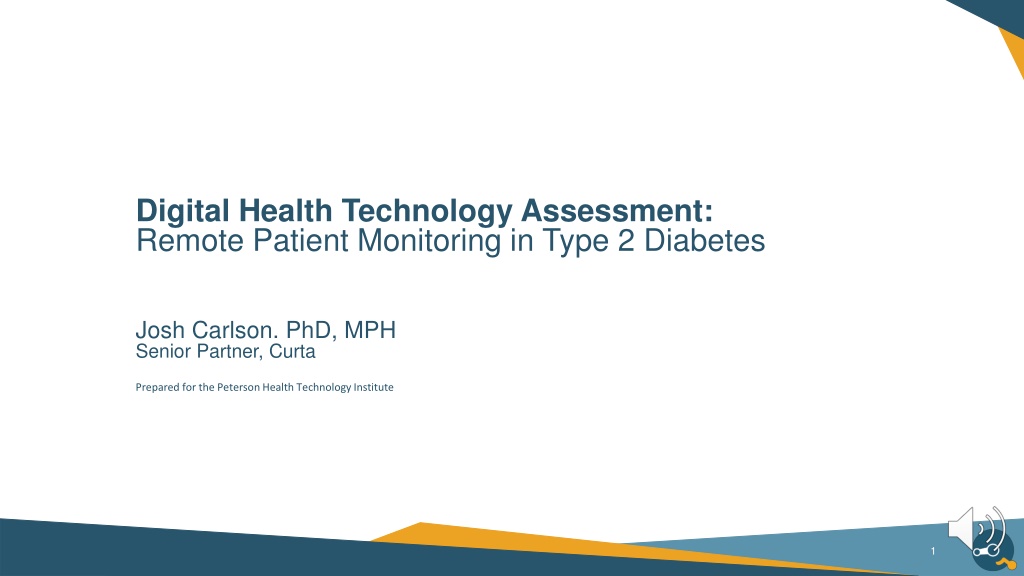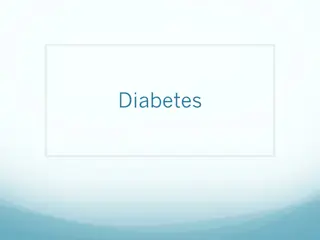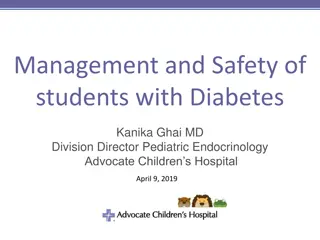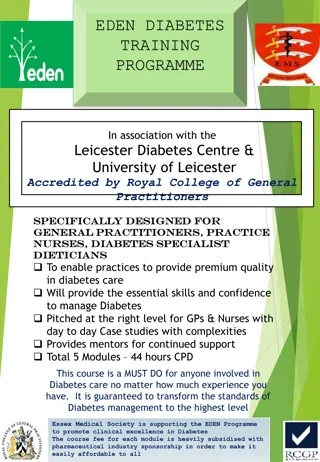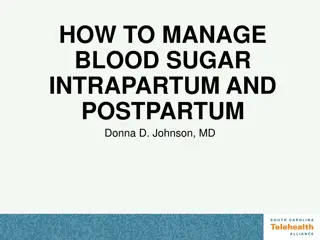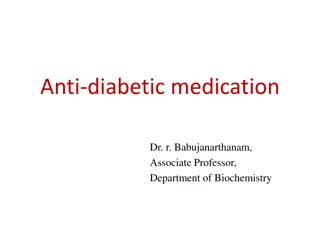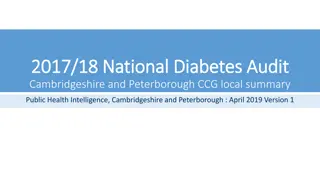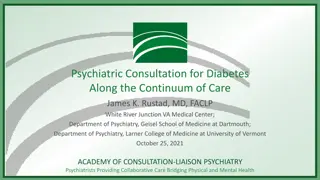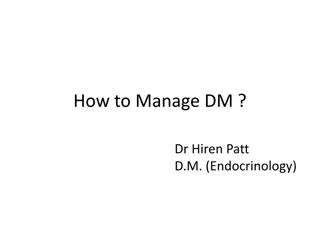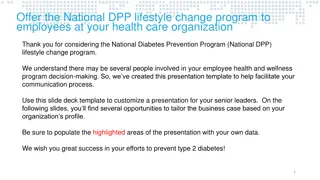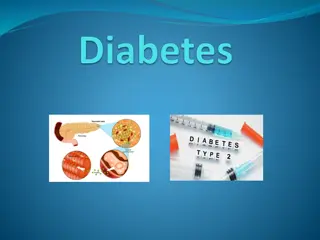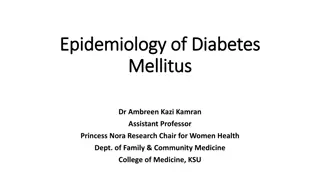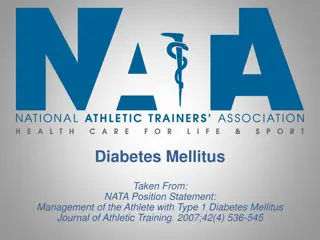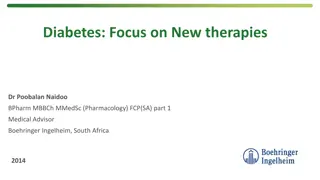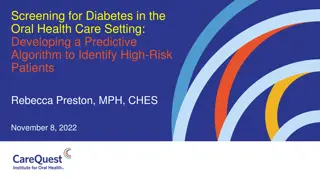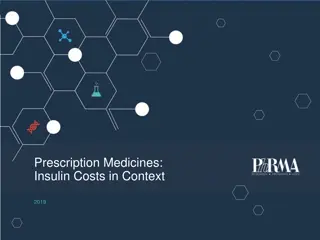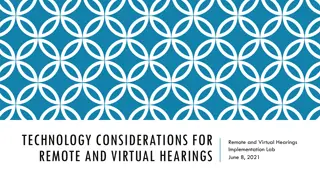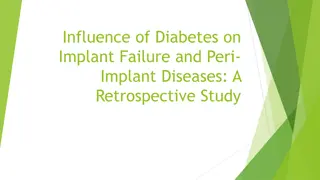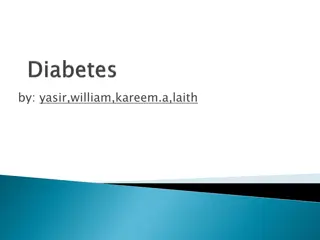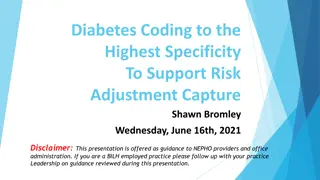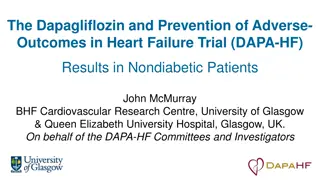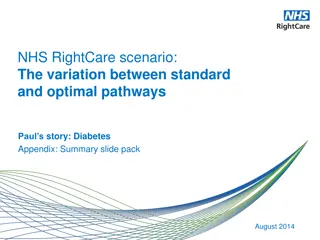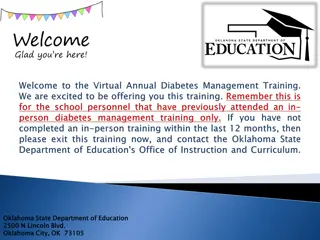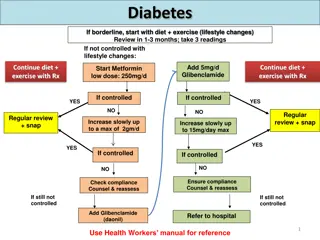Digital Health Technology Assessment: Remote Patient Monitoring in Type 2 Diabetes
This assessment focuses on the clinical and economic impact of remote patient monitoring in adults living with type 2 diabetes. It includes a systematic literature review with high-level protocols, outcome measures, and economic impact analysis. The overarching framework explores the use of digital health technology in comparison to usual care, emphasizing the resource utilization and cost implications. Overall, it aims to provide valuable insights into leveraging technology for managing type 2 diabetes effectively.
- Remote Patient Monitoring
- Type 2 Diabetes
- Clinical Impact
- Economic Analysis
- Digital Health Technology
Download Presentation

Please find below an Image/Link to download the presentation.
The content on the website is provided AS IS for your information and personal use only. It may not be sold, licensed, or shared on other websites without obtaining consent from the author. Download presentation by click this link. If you encounter any issues during the download, it is possible that the publisher has removed the file from their server.
E N D
Presentation Transcript
Digital Health Technology Assessment: Remote Patient Monitoring in Type 2 Diabetes Josh Carlson. PhD, MPH Senior Partner, Curta Prepared for the Peterson Health Technology Institute 1
Clinical Impact: Systematic Literature Review 2
Systematic Literature Review: High Level Protocol Category Inclusion Criteria Exclusion Criteria Adults living with type II diabetes mellitus Adults or children with Type 1 diabetes mellitus Children with Type 2 diabetes mellitus Population Blood glucose monitoring (non-continuous) with associated mobile or web application. Continuous glucose monitoring systems Standalone health applications and person devices Smart insulin pens and pen caps Standalone insulin pumps Non-invasive sensors Not applicable Interventions Standard of care (fingerstick blood glucose meter) or usual care. Comparators HbA1c level Body weight Cardiovascular risk factors Cardiovascular events Safety of connected blood glucose meters PROs Safety User experience Clinical trials (phase 2 or 3; single arm or controlled) Observational (prospective and retrospective) studies Systematic reviews and meta-analysis Patient satisfaction Adherence Use of medication HCRU (ED, hospitalization, clinic visits) Shifts in care delivery driven by connected blood glucose meters Health equity connected blood glucose meters Health equity Not applicable Outcomes Outcomes HbA1c level Body weight Cardiovascular risk factors Cardiovascular events Safety of connected blood glucose meters PROs Safety User experience Patient satisfaction Adherence Use of medication HCRU (ED, hospitalization, clinic visits) Shifts in care delivery driven by Commentary, letters, editorials, opinions, study protocols Non-systematic and narrative reviews Case reports or series Study designs Global Interventions not approved or available in the United States Geography Articles and abstracts published in English Not applicable Language Databases: 2013 to 2023 (MEDLINE[via PubMed] and EMBASE] Conferences: 2021 to 2023 (Conference proceedings) Not applicable Date of publication 3 3
Systematic Literature Review Protocol published and publicly available 4 4
Economic Impact: Budget Impact Analysis 5
Overarching Economic Impact Framework for DHTs Health Care Resource Use Impact Categories Economic Impact (Resource Use X Unit Cost) Evidence Indirect Cost Impacts via Clinical Outcomes Evidence linking interventions to clinical outcomes Evidence linking clinical outcomes to resource use Physician Visits Specialty Visits Imaging Digital Health Technology Vs. Usual Care Payer: Laboratory Tests Reimbursements for Intervention Reimbursements for HCRU Medications Emergency Room Visits Direct Cost Impacts Hospitalizations Surgeries 6 6
Analysis Decision Problem - Diabetes Adults with Type 2 diabetes Population Closed cohort Model Approach Commercial, Medicare and Medicaid payer perspectives Perspective Non-continuous blood glucose monitoring with associated mobile or web application that are part of a comprehensive T2D control programs; interventions to be evaluated at the company product-specific level Intervention Usual care (fingerstick blood glucose meter) Comparators Intervention costs Outpatient care costs Pharmacy costs Inpatient care costs Cost categories Total costs for remote patient monitoring and usual care scenarios Incremental cost per end user adhering to DHT Incremental cost per 1,000 users reflecting adherence Incremental cost per user per month Incremental cost per member per month Budget impact outputs Analysis with threshold prices to achieve different levels of cost savings Scenario analyses 1-3 years Time horizon Excel Software 7 7
Type 2 Diabetes Budget Impact Schematic: Indirect Approach Drug Costs Connected glucose meter HbA1c Outpatient Costs Acute Care Costs Diagnosed Type 2 diabetes patients recommended to receive non-continuous blood glucose monitoring Drug Costs Unconnected glucose meter HbA1c Outpatient Costs Acute Care Costs Impact of connected glucose monitoring devices on HbA1c level will be informed by the SLR Impact of HbA1c to healthcare costs will be informed by a retrospective claims analysis1 1. Boye KS, Lage MJ, Thieu VT. The Association Between HbA1c and 1-Year Diabetes-Related Medical Costs: A Retrospective Claims Database Analysis. Diabetes Ther. 2022 Feb;13(2):367-377. 8 8
Diabetes Patient Population Funnel Hypothetical Million-Member Health Plan 1,000,000 Assumed plan population 77.7% % Adults1 11.3% Prevalence of diagnosed diabetes2 23,322 to 58,305 95% % Type 2 diabetes3 15% % Use insulin to control blood blood glucose levels4 55% % Utilization of self-monitoring blood glucose device5 6,881 # Total potential users # US Census Bureau. Age and Sex Composition in the United States: 2022. Available at: https://www.census.gov/data/tables/2022/demo/age-and-sex/2022-age-sex-composition.html. Accessed September 18, 2023. Centers for Disease Control and Prevention. National Diabetes Statistics Report website. https://www.cdc.gov/diabetes/data/statistics-report/index.html. Accessed September 18, 2023. Centers for Disease Control and Prevention. Type 2 Diabetes. https://www.cdc.gov/diabetes/basics/type2.html#:~:text=More%20than%2037%20million%20Americans,adults%20are%20also%20developing%20it. Accessed September 18, 2023. Willner S, Whittemore R, Keene D. "Life or death": Experiences of insulin insecurity among adults with type 1 diabetes in the United States. SSM Popul Health. 2020 Jun 27;11:100624. 9 9 Perez-Nieves M, Juneja R, Fan L, et al. Trends in U.S. Insulin Use and Glucose Monitoring for People with Diabetes: 2009-2018. J Diabetes Sci Technol. 2022 Nov;16(6):1428-1435..
Sample Budget Impact Results Table Payer Costs (HCRU and DHT Care) Outcomes Scenario without RPM Scenario with RPM Budget Impact Total cost $X $Y =($Y - $X) Cost per 1,000 users $X $Y =($Y - $X) Cost per user per month $X $Y =($Y - $X) Cost per-member per- month $0.XX $0.YY =($0.YY - $0.XX) 10 10
